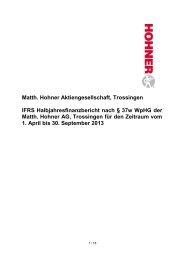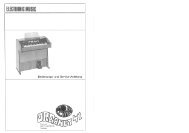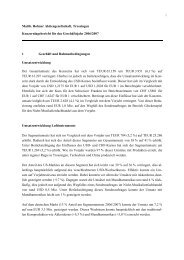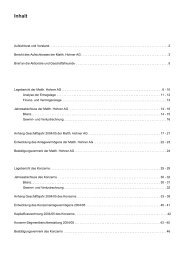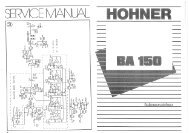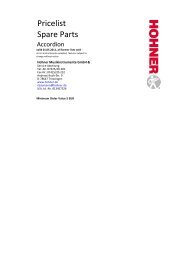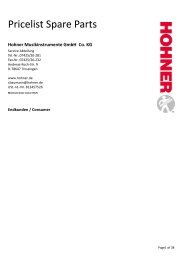Matth. Hohner AG
Matth. Hohner AG
Matth. Hohner AG
You also want an ePaper? Increase the reach of your titles
YUMPU automatically turns print PDFs into web optimized ePapers that Google loves.
Notes to the Consolidated Financial Statements for Business Year 2010/2011<br />
Credit Risks<br />
Credit risks consist of the economic loss of a financial asset, the loss of the contractual payment obligation of<br />
the contractual partner and the worsening of its creditworthiness, combined with the risk of a concentration<br />
on few contractual partners (bulky risk). Credit risks may occur in the IFRS 7-categories “Available for Sale<br />
(AfS)”, “Loans and Receivables (LaR)”, “Financial Assets Held for Trading (FAHfT)” and “Cash on hand and<br />
bank balances (Cash)”. The creditworthiness of our customers is continuously checked and credit limits are<br />
adjusted accordingly. As a result of the sales structure implemented in Germany, there are bulky risks with<br />
respect to trade receivables. These risks are continuously identified and assessed. Within the scope of its<br />
operative business HOHNER Group is engaged in countries, in which economic risks can be found. At present<br />
those risks do not have any impact on the group. In order to minimize these risks the corporate policy is to use<br />
certain terms of payment<br />
(e. g. cash in advance).<br />
Available for Sale Financial Assets (AfS): This category mainly contains shares in investments, valued at-equity,<br />
as well as shares in a minority investment (other financial assets). The maximum credit risk of this category<br />
equals its book value. The Group considers it not to be material.<br />
Loans and Receivables (LaR): The risk within this class is taken into account by bad debt allowances.<br />
The maximum credit risk of this category equals its book value.<br />
Cash on hand and bank deposits (Cash): This category mainly contains cash and bank deposits with short<br />
maturity. There are no credit risks. The maximum credit risk of this category equals its book value.<br />
Financial Assets Held for Trading (FAHfT): This category contains derivative financial instruments that are<br />
solely used for hedging in the Group. The contractual partners for these derivative financial instruments are<br />
especially international financial institutions. There are currently no overdue payments or allowances due to<br />
losses.<br />
Liquidity risks<br />
Liquidity risk describes the risk, that the Group cannot or only to a limited extent fulfill its financial obligations.<br />
Cash and cash equivalents and unused lines of credit ensure liquidity of HOHNER Group. Besides bank loans,<br />
most group financing is provided by the majority shareholder H.S. Investment Group Inc., whereby the<br />
financial planning of the HOHNER Group takes all debt servicing into account.<br />
Market risks<br />
Economic trends of our most important markets may influence our business by changes in consumer behavior.<br />
This may either positively or negatively influence sales and net income. Due to the worldwide economic<br />
situation, which has not completely recovered yet, an outlook for the future is combined with a lot of<br />
uncertainties. A slight improvement could be felt on nearly all markets in the last months; however, it cannot<br />
be referred yet to a general recovery. Therefore, for the business year 2011/2012, the group anticipates sales<br />
slightly above previous year’s level.<br />
Foreign exchange and interest rate risk<br />
Due to its international operations, HOHNER Group is also exposed to currency and interest rate fluctuations.<br />
It is company policy to exclude or limit these risks as far as possible by entering into hedge transactions.<br />
Foreign exchange risks exist in particular where sales and purchases of materials exist or will arise in the<br />
ordinary course of business in a currency other than the local currency of the entity. Forward exchange<br />
contracts are used to hedge these planned sales and purchases of materials and also where materials are<br />
purchased in a foreign currency, the related sales are also made in that currency so as to reduce the currency<br />
risk to a minimum. Hedging mainly pertained to the US dollar and the Japanese yen.<br />
Notes to the CoNsolidated FiNaNCial statemeNts Notes to the CoNsolidated FiNaNCial statemeNts<br />
107



